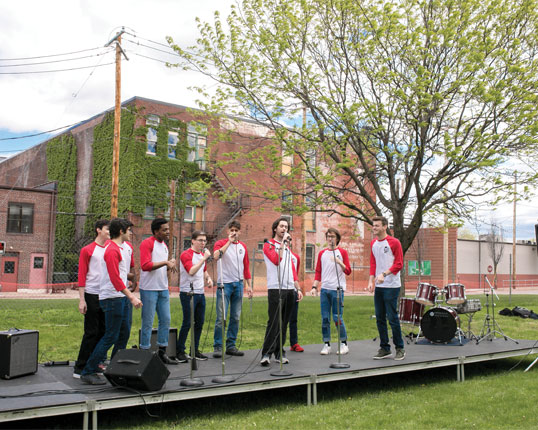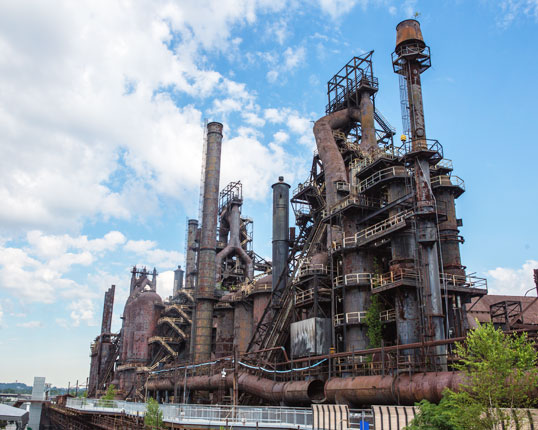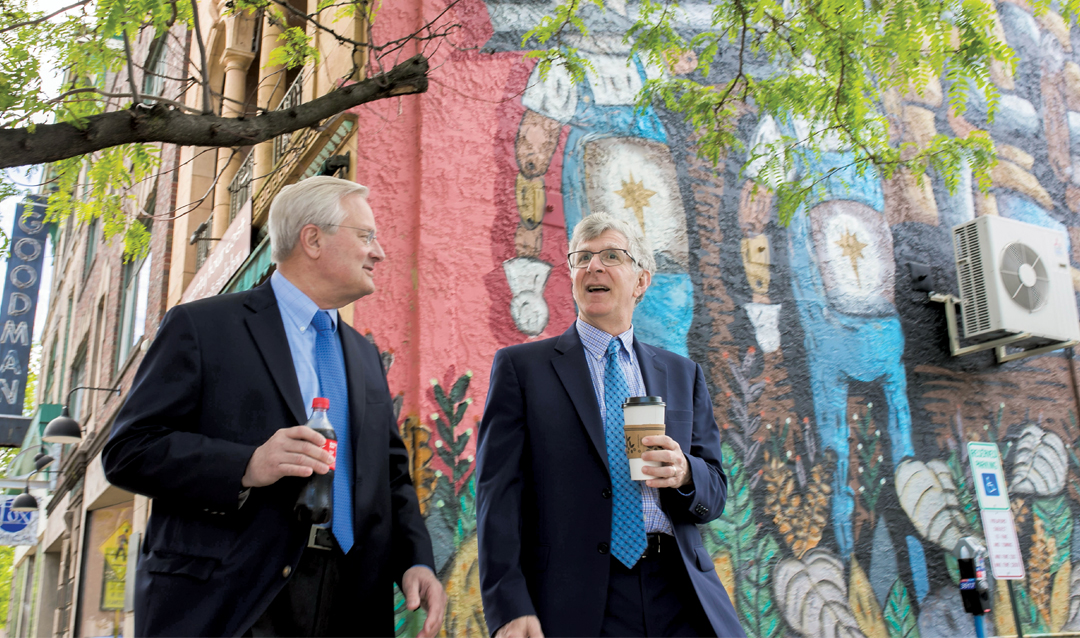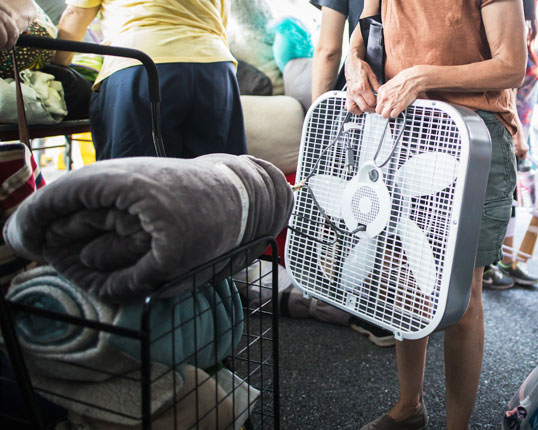On the last Saturday in April, with the annual Spring on the SouthSide community festival and chili cook-off underway, clusters of families and friends strolled the streets of South Bethlehem, stopping to sample the chili at businesses and organizations competing for bragging rights and trophies.
Sunrise on the South Side
Getting your Trinity Audio player ready...
Lehigh, its partners in the community and the City of Bethlehem join forces to foster South Bethlehem’s resurgence.
Posted on
October 30, 2019
Sunrise on the South Side
Lehigh, its partners in the community and the City of Bethlehem join forces to foster South Bethlehem’s resurgence.
On the last Saturday in April, with the annual Spring on the SouthSide community festival and chili cook-off underway, clusters of families and friends strolled the streets of South Bethlehem, stopping to sample the chili at businesses and organizations competing for bragging rights and trophies.

Lehigh’s a cappella group A Whole Step Up performs at Spring on the SouthSide community festival.
Music blared, on the streets and along the Greenway, where Lehigh’s a cappella group A Whole Step Up took stage early in the day. Occasionally, the wind played havoc with pop-up tents and tested Lehigh students who were trying to spin blue cotton candy onto paper cones for younger festival-goers. Other visitors jousted and swung bats at two inflatables set up on the Greenway, courtesy of Lehigh Student Senate’s Bethlehem Outreach Committee.
A half hour into the start of the festival, Downtown Manager Missy Hartney, whose position was created as a result of an ongoing partnership between Lehigh and the City of Bethlehem, beamed. The chili passport tickets were nearly sold out. Lehigh students were running a wide swath of new activities on the Greenway in tandem with the SouthSide Arts District, and business owners were opening their doors to festival-goers—and potential new customers.
Tasked with helping to stimulate growth on the South Side, Hartney had cause to be happy, and it went well beyond the appeal of the chili cook-off. In the weeks leading up to the festival, which attracted about 2,000 people, she gave this assessment: “More and more cool things are happening on the South Side.”
Indeed.
Lehigh, its partners in the community and the City of Bethlehem join forces to foster South Bethlehem’s resurgence.
In the two decades since local steelmaking operations ended at the Bethlehem Steel Corp., which had employed tens of thousands of people at its height and produced the steel that built the Golden Gate Bridge and other landmarks, the South Side of Bethlehem is having its moment. New buildings, new restaurants and new public art have sprouted in a section of the city rich in diversity. Festivals have taken root, and some of the old Steel properties have been reimagined into cultural destinations.

The Steelstacks is a prominent reminder of South Bethlehem’s proud past.
While much can be attributed to the ingenuity, creativity and hard work of untold people—from community residents to longtime business owners, city leaders and other visionaries—Lehigh, the City of Bethlehem and other strategic partners have joined together on a number of initiatives to help foster the South Side’s resurgence, make the city a more vibrant, interesting place to live, and tackle lingering challenges.
“We are linked at the hip,” says Lehigh President John D. Simon ’19P, in describing the relationship between the university and the city. “The students who come to Lehigh have to call Bethlehem home. I want them to see themselves as part of the community and to participate in the community. The residents of Bethlehem have to see Lehigh as one of the major employers and a strong academic institution. That links to the ability to attract businesses and jobs. So I think it’s a very symbiotic relationship.”
At Simon’s invitation, Bethlehem Mayor Robert Donchez welcomes each incoming class at Lehigh’s annual Convocation, encouraging students to visit restaurants and stores and to take in the many nearby music and arts venues, including the ArtsQuest Center at SteelStacks.
He assures students that city officials are committed to their safety and points out that Bethlehem was recently ranked among the top 50 safest college cities.
A previous generation knew a different Bethlehem. When the Steel plant stopped making steel in 1995 after 120 years, and its coke division shut down in 1998, it marked the end of an era. Left behind was an 1,800-acre brownfield and much uncertainty, with ripple effects measured in lost jobs, abandoned houses and storefronts, and dwindling customers for shop owners and restaurants.

Bethlehem Mayor Robert Donchez (left) and Lehigh President John D. Simon say the relationship between the university and the city is stronger today than ever before.
“When I speak at Lehigh,” says Donchez, “my point to them is, maybe your parents were here 20 years ago or 30 years ago. They remember the old Bethlehem. We’re going through a revitalization.”
Donchez views the relationship between Lehigh and the city as “a great partnership.” “We all just want to work together to benefit the community of South Bethlehem, to benefit the city, to benefit Lehigh,” he says. “So it’s a win-win.”
The university has a long history of collaboration with the City of Bethlehem, but Lehigh’s leadership developed a more formal framework for community engagement over the past decade. As an anchor institution, Lehigh developed a four-pronged approach for engaging with the community that continues today, says Fred McGrail, vice president of communications and public affairs at Lehigh. The strategies, supported by its Board of Trustees, center on creating a clean and safe environment, supporting public education, encouraging commercial vitality and revitalizing neighborhoods.
“South Bethlehem really is a great comeback story,” McGrail says. “Part of the reason for that is, people who’ve lived in that community and worked in that community and had businesses in that community, never gave up. When the times were the toughest, they were the ones who kept pushing forward, sometimes against seemingly insurmountable odds.”
Much of the progress, he says, has been built on the foundation they laid. “There’s still a lot to do,” McGrail says, “but there’s reason for optimism. And I’m proud and gratified that Lehigh is playing a role in the South Side’s renewal.”
President John D. Simon talks about town-gown relationships.
Simon sees the strategies as “four legs of the stool. They all actually influence each other,” he says. So when Lehigh contemplates potential partnerships with the city, “we stand them against those four objectives and try to make sure that they contribute to all of those missions.”

Lehigh’s Great South Side Sale recycles students’ discarded items for sale. Profits are funneled back into community programming for local school children.
In addition to the downtown manager position, Lehigh and the city forged a partnership to create the SouthSide Ambassadors, the gold-and-blue-clad security officers who remove litter from sidewalks, clean away graffiti, assist visitors with directions and provide a host of other services. The Lehigh University Police Department works in concert with Bethlehem police and other organizations to keep neighborhoods safe. Two city code enforcement officers, whom Lehigh financially supports, inspect off-campus properties that students and others rent to make sure they are up to code. Members of the Lehigh faculty affiliated with the South Side Initiative offer a number of courses that examine the area’s architecture, history and evolution, and work to archive the area’s culturally rich and diverse history.
Initiatives include Lehigh’s Move Out Collection Drive and the Great South Side Sale, where students’ discarded items at the end of an academic year are recycled for sale and profits are funneled back into community programming for local school children.
“It only takes one or two houses our students are in, where they line the streets with furniture and other items they want to get rid of, or the trash from their houses, to hear feedback from the city that we don’t take care of the neighborhoods where our students live,” Simon says. “People are sensitive to all of these issues, whether we do our part to keep the city clean, whether we do our part to spur the economy, whether we do our part to respect the residents who are not Lehigh students who live in the city. All these are important for the institution to take ownership of and work into the strategies” in partnering with the city.
Posted on
October 30, 2019





